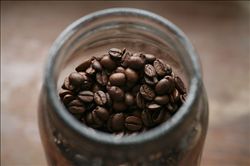The morphological characteristics of coffee trees the geographical distribution of coffee trees
Coffee Fruit Coffee Tree is a shrub or small tree of Rubiaceae; its leaves are opposite, leathery and long ovate; every March, the branches appear white flowers, petals spirally arranged, and the heart jumps around the petals. Take a closer look, it is really like a small windmill playing in childhood, emitting bursts of jasmine fragrance The fruit is oval, berries, crimson, containing two seeds, that is, we are familiar with coffee beans. The first flowering period of the white flower red fruit coffee tree is about three years old. the five-petal tube-shaped white flowers are filled with a faint fragrance of jasmine and the inflorescences are arranged in dense clusters. Flowers wither after two or three days of blooming and begin to bear fruit after a few months. The fruit is a drupe with a diameter of about 1.5cm. It turns green at first, then turns yellow gradually, and turns red when ripe. It is very similar to cherries, so it is called cherry coffee (Coffee Cherry). It can be harvested at this time. Coffee trees the ripe coffee berries of coffee trees are bright red with sweet flesh and contain a pair of seeds, namely coffee beans (Coffee Beans). Coffee varieties can be divided into small-grain, medium-grain and large-grain species, the former contains low caffeine content and strong flavor, while the latter two have high caffeine content but poor flavor. Coffee sold in the world is generally made of small and medium seeds in different proportions, usually 70% of medium seeds, mainly caffeine, and 30% of small seeds, mainly for their aroma. Each coffee variety generally has a few to a dozen variants. Coffee is more resistant to shade and cold, but not resistant to light, drought and disease. Coffee contains nine kinds of nutrients, such as caffeine, protein, crude fat, crude fiber and sucrose. As a beverage, coffee is not only mellow and delicious, slightly bitter and sweet, but also can excite nerves and dispel fatigue. In medicine, caffeine can be used as an anesthetic, stimulant, diuretic and cardiotonic, as well as to help digestion and promote metabolism. The pulp of coffee is rich in sugar and can be used to make sugar and alcohol. Coffee flowers contain essential oils that can be used to extract high-grade spices. [2] Coffee trees like mild temperatures during the day and less than two hours of direct sunshine, so if coffee trees lack the afternoon showers or thick fog to report every day, local farmers have to plant many taller trees in the coffee garden for shade. At night, they want an environment of about ten degrees Celsius but not too low, because too warm will make the coffee berries grow too fast to produce small, strong, hard and high-quality coffee beans; in case it is too cold to frost, the coffee trees will freeze to death. Based on these characteristics, the promised land suitable for Arabica coffee is mostly located in countries with alpine terrain between the Tropic of Cancer, which is also known as the coffee belt (Coffee Zone/Coffee belt). As an elegant, fashionable and high-grade beverage, coffee has long been popular all over the world, and it has been listed as the first of the three major beverages (coffee, tea and cocoa) in the world. Coffee has been planted in 76 countries and regions all over the world. In 1983-1984 alone, the world's coffee output reached as much as 5.5 million tons, with an export volume of 4.2 million tons, of which Brazil in South America, known as the "coffee kingdom", produced and exported the most. In spite of this, the hometown of coffee is not in Brazil, but in Ethiopia in Africa. to this day, there is still a large area of wild coffee forest in the dense jungle of the southwestern province of Cafa. The word "coffee" comes from the place name "Kafa".

Important Notice :
前街咖啡 FrontStreet Coffee has moved to new addredd:
FrontStreet Coffee Address: 315,Donghua East Road,GuangZhou
Tel:020 38364473
- Prev

The planting Environment of Coffee trees what kind of environment does coffee trees need to have?
The planting of coffee trees has great requirements on the environment. There are only two areas in China where coffee trees can be planted. The origin of coffee trees is Ethiopia in Africa. In botany, coffee tree belongs to the evergreen tree of the subgenus Rubiaceae, and coffee beans, commonly known as coffee beans, are the seeds of the fruit of coffee trees, just because they are shaped like beans, so they are called coffee.
- Next

Boutique coffee Papua New Guinea content Papua New Guinea Origin
Babu coffee flavor and taste characteristics: full particles, moderate acidity, mellow taste. Papua New Guinea is an island country in Oceania. Papua means curly hair in Malay. It is said that in 1545, the explorer Retes arrived on the island and found that most of the people on the island had curly hair, that is, the island was called the island of curly hair.
Related
- Does Rose Summer choose Blue, Green or Red? Detailed explanation of Rose Summer Coffee plots and Classification in Panamanian Jade Manor
- What is the difference between the origin, producing area, processing plant, cooperative and manor of coffee beans?
- How fine does the espresso powder fit? how to grind the espresso?
- Sca coffee roasting degree color card coffee roasting degree 8 roasting color values what do you mean?
- The practice of lattes: how to make lattes at home
- Introduction to Indonesian Fine Coffee beans-- Java Coffee producing area of Indonesian Arabica Coffee
- How much will the flavor of light and medium roasted rose summer be expressed? What baking level is rose summer suitable for?
- Introduction to the characteristics of washing, sun-drying or wet-planing coffee commonly used in Mantenin, Indonesia
- Price characteristics of Arabica Coffee Bean Starbucks introduction to Manning Coffee Bean Taste producing area Variety Manor
- What is the authentic Yega flavor? What are the flavor characteristics of the really excellent Yejasuffi coffee beans?

